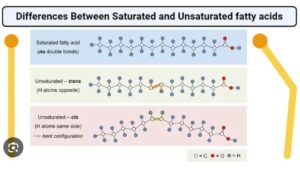
Có vẻ như trong một thời gian dài đã có một chút kỳ thị xung quanh từ 'chất béo' và rằng nó không thực sự được coi là người bạn tốt nhất khi nói đến thực phẩm. Mặc dù điều này đúng với một số chất béo, nhưng có những chất béo khác lại cực kỳ quan trọng đối với chế độ ăn uống và sức khỏe của bạn. Có thể có trường hợp có quan niệm sai lầm về cái nào là cái nào! Vì mục đích này, chúng tôi nghĩ rằng sẽ là một ý tưởng hay khi phân tích chủ đề phức tạp này và xóa tan một số huyền thoại xung quanh chất béo để cho bạn biết lý do tại sao việc đưa chúng vào chế độ ăn uống của bạn lại quan trọng đến vậy.

Axit béo, bão hòa và chuỗi
Vì axit béo (FA) rất cần thiết cho sự sống trên trái đất, nên mọi thực phẩm chúng ta ăn đều chứa chất béo, ngay cả khi, trong trường hợp của một số loại trái cây, lượng chất béo chỉ khoảng 0,001%. Và mọi chất béo trong mọi thực phẩm đều là sự kết hợp của axit béo bão hòa (SFA), axit béo không bão hòa đơn (MUFA) và axit béo không bão hòa đa (PUFA), theo các tỷ lệ khác nhau. Không có chất béo bão hòa đơn thuần và không có chất béo không bão hòa đơn thuần hoặc đa bão hòa. Có vô số các loại FA chuỗi ngắn, trung bình và dài, trong 3 mức độ bão hòa, ví dụ như stearic, palmitic, lauric, butyric, linoleic, arachidonic (Omega-6) và docosahexaenoic (DHA—Omega-3), chỉ kể đến một số ít! Axit stearic, palmitic, myristic, lauric, caprylic và butyric là những ví dụ về axit béo bão hòa, trong đó axit palmitic chuỗi dài (C16:0) là dạng chất béo “lưu trữ” phổ biến và được ưa chuộng nhất của cơ thể. Axit butyric (C4:0), hay butyrat, là một loại axit béo chuỗi ngắn nổi tiếng có trong bơ và ghee (lượng nhỏ), cũng được tạo ra bởi vi khuẩn đường ruột để nuôi các tế bào niêm mạc ruột. Axit lauric (C12:0) là loại axit béo phổ biến nhất trong dầu dừa và là một loại axit béo chuỗi trung bình.
Chất béo Omega 3 và 6
Omega-6 và 3 FA được coi là thiết yếu vì chúng ta không thể tự tạo ra chúng trong cơ thể. Omega 3 dường như có tác động tích cực đến sức khỏe tim mạch của chúng ta và nó cũng rất tốt trong việc hỗ trợ miễn dịch khỏe mạnh phản ứng. Omega-6 FA được coi là có vấn đề, nhưng axit arachidonic (C20:4) thực sự rất cần thiết và nó thực hiện nhiều chức năng trong cơ thể. Chúng ta thực sự không cần một lượng lớn các axit béo này, ngoại trừ ở trẻ em hoặc khi mang thai. Điều quan trọng hơn là tỷ lệ omega 6 so với 3 phải ở mức lành mạnh—từ 1:1 đến 4:1—nhưng các nghiên cứu cho thấy chế độ ăn uống điển hình của phương Tây có tỷ lệ khoảng 16:1 hoặc thậm chí cao hơn.
Chất béo bão hòa…
…được gọi như vậy vì ở cấp độ phân tử, các liên kết cacbon được “bão hòa” hoàn toàn với các nguyên tử hydro. Điều này làm cho các axit béo bão hòa thường rắn và đông ở nhiệt độ phòng, không dễ bị oxy hóa và rất ổn định khi nấu ăn. Chất béo bão hòa sẽ không “làm tắc nghẽn động mạch của bạn”, một phần vì cơ thể chúng ta quá ấm để bất kỳ chất béo nào vẫn ở trạng thái rắn! Các loại chất béo ổn định nhất là chất béo của động vật nhai lại (bò, cừu, v.v.) như mỡ động vật, mỡ bò và mỡ trên thịt đỏ. Bơ và bơ ghee cũng có độ bão hòa cao và rất ổn định, mặc dù các protein sữa còn lại trong bơ có thể khiến bơ bị cháy khi chiên. Gọi chất béo động vật là “bão hòa” là bỏ qua các thành phần không bão hòa đơn và không bão hòa đa của chất béo nói chung. Ví dụ, chất béo thịt bò trung bình bão hòa gần 50%, nhưng cũng xấp xỉ 45% không bão hòa đơn và 5% không bão hòa đa—một tỷ lệ hoàn hảo cho sức khỏe con người. Suet, chất béo được đánh giá cao xung quanh thận, chứa một lượng lớn axit stearic, một chất béo có liên quan chặt chẽ đến cân nặng khỏe mạnh và khối lượng cơ nạc. Bơ đã được chứng minh là làm tăng năng lượng có sẵn thậm chí lên đến 8 giờ sau bữa ăn, góp phần vào cân nặng khỏe mạnh. Không có gì ngạc nhiên khi trong các quần thể người nguyên thủy sử dụng bơ, nó được coi là một loại thực phẩm thiêng liêng.
Ngược lại với chất béo không bão hòa,
thường ở dạng lỏng ở nhiệt độ phòng, dễ bị oxy hóa và rất không ổn định. Chúng ta biết chúng là dầu trái cây như ô liu và bơ, hoặc dầu hạt/thực vật như dầu hạt lanh, đậu nành, cám gạo và cải dầu, nhưng một lần nữa, chúng không chỉ không bão hòa mà còn chứa tỷ lệ chất béo bão hòa so với chất béo không bão hòa. Dầu ô liu là một loại lipid có nguồn gốc từ trái cây (chất béo) và có khoảng 73% chất béo không bão hòa đơn, 14% chất béo bão hòa và 11% chất béo không bão hòa đa. Đáng ngạc nhiên là dầu dừa, một loại dầu trái cây, là chất béo bão hòa nhất trong vương quốc thực phẩm, với khoảng 90-92% chất béo bão hòa, 6-8% chất béo không bão hòa đơn và phần còn lại là chất béo không bão hòa đa.
Để làm mọi thứ trở nên khó hiểu hơn, chất béo không bão hòa đa cũng bao gồm các axit béo thiết yếu, axit docosahexaenoic (DHA—C22:6 [n-3]), axit eicosapentaenoic (EPA—20:5 [n-3]) và axit arachidonic (AA hoặc ARA). Như đã thảo luận, axit béo omega là thiết yếu vì chúng ta không thể tự tạo ra chúng trong cơ thể mà phải lấy từ chế độ ăn uống. Quan trọng nhất trong số các axit béo chuỗi dài này là AA và DHA. Omega-3, DHA và EPA, và omega-6, AA, chỉ có trong thực phẩm động vật. Các dạng thực vật của omega 3, axit alpha-linolenic và omega 6, axit linoleic, được chuyển đổi kém thành các dạng có thể sử dụng được ở hầu hết chúng ta. Dầu tảo có chứa DHA, EPA và AA, nhưng chúng vẫn ở dạng mà chúng ta cũng cần chuyển đổi trong cơ thể, vì vậy chúng không phải là chất thay thế hoàn toàn đáng tin cậy cho chất béo động vật trong chế độ ăn uống.
Khoa học kỳ lạ
Trong một thời gian, do khoa học chưa đầy đủ và không chính xác được thực hiện vào giữa thế kỷ trước, người ta cho rằng sử dụng dầu thực vật không bão hòa có lợi hơn chất béo bão hòa vì nó "tốt hơn cho sức khỏe tim mạch". Nguyên nhân là do ăn dầu không bão hòa "làm giảm mức cholesterol trong máu". Bây giờ chúng ta biết rằng cholesterol không phải là nguyên nhân gây ra các vấn đề. Cholesterol rất cần thiết cho mọi động vật và cơ thể chúng ta tạo ra phần lớn lượng cholesterol mà chúng ta cần.

Điều gì làm nên dầu không bão hòa đa…
…nguy hiểm hơn đối với sức khỏe tim mạch của chúng ta là khi chúng được đun nóng, dầu sẽ bị oxy hóa, tạo ra các gốc tự do, có thể gây tổn hại đến động mạch và tế bào. Chúng được gọi là dầu thực vật, nhưng chúng không liên quan nhiều đến thực vật. Chúng được chiết xuất từ hạt và hầu hết là dầu được chế biến công nghiệp, quá trình này tạo ra các hóa chất độc hại trong dầu. Dầu hydro hóa, có trong bơ thực vật, v.v., được thay đổi để hoạt động giống như chất béo bão hòa—trở nên rắn ở nhiệt độ phòng—và nguy hiểm nhất vì nó trở thành chất béo chuyển hóa. Mặc dù một lượng rất nhỏ dầu hạt hữu cơ ép lạnh là ổn, hãy bỏ bơ thực vật và chỉ dùng bơ! Sử dụng các chất béo động vật khác để nấu ăn và giữ lại dầu ô liu và quả bơ nguyên quả để làm salad, sốt mayonnaise, v.v.
Một lý do khác khiến chúng ta nên tránh dầu thực vật là vì chúng chứa hàm lượng axit linoleic (LA-18:2 [n-6]) tương đối cao, một loại axit béo omega-6. Một lượng nhỏ có trong thực phẩm truyền thống, nhưng với dầu thực vật trong hầu hết các loại thực phẩm chế biến, chế độ ăn uống hiện đại của chúng ta lại chứa quá nhiều LA. Vấn đề với LA dư thừa rất phức tạp, nhưng vấn đề chính là nó dễ bị oxy hóa như thế nào, nó cạnh tranh với omega-3 như thế nào để chuyển hóa, các sản phẩm phân hủy có hại của nó (OXLAMS và aldehyde) và cách nó chiếm đoạt mức độ no thông qua hoạt hóa thụ thể cannabinoid ở ruột non gần. Mô mỡ và màng tế bào của người béo phì đã được chứng minh là chứa hàm lượng LA cao hơn nhiều so với những người có khối lượng mỡ bình thường.
Dầu thực vật cũng chứa phytosterol, cạnh tranh với cholesterol để sử dụng trong cơ thể. Cholesterol rất cần thiết cho sự sống và khoảng 80% cholesterol được tạo ra trong gan. Cholesterol quan trọng đến mức não tự tạo ra cholesterol. Dầu dừa rất ổn định để nấu ăn vì nó có độ bão hòa cao; tuy nhiên, là một loại dầu thực vật, nó có chứa phytosterol, mặc dù ở mức thấp hơn nhiều so với dầu hạt. Dầu dừa là loại dầu thực vật an toàn nhất để nấu ăn.
Chất béo làm nhiên liệu

Chất béo có thể được sử dụng như một loại nhiên liệu, giống như glucose, nhưng theo một cách khác trong ty thể của chúng ta (nhà máy điện của tế bào). Một quá trình trao đổi chất lành mạnh không bị quá tải năng lượng và có thể chuyển đổi giữa 2 nguồn nhiên liệu này (và hai chất nền khác là ketone và lactate). Glucose được cho là nhiên liệu chính được sử dụng trong giờ thức và để chuyển động nhanh, "bùng nổ", trong khi chất béo được "đốt cháy" ưu tiên trong khi ngủ và trong các hoạt động đòi hỏi sức bền, nhưng một quá trình trao đổi chất lành mạnh sẽ có thể hoán đổi giữa chúng tương đối dễ dàng. Chất béo cũng có thể được sử dụng dưới dạng ketone, nhưng đó là chủ đề của một ngày khác! Điều quan trọng cần nhớ là nếu bạn không ăn thực phẩm siêu chế biến hoặc nhiều dầu tinh chế và đường, để giữ insulin ở mức bình thường, bạn sẽ có thể dễ dàng chuyển đổi giữa các nguồn nhiên liệu.
Sự thật cuối cùng về chất béo
Điều quan trọng cần nhớ là chất béo là một phần quan trọng trong chế độ ăn uống của chúng ta và nên được ăn dưới dạng thực phẩm nguyên chất, không phải dưới dạng dầu được sản xuất công nghiệp. Ăn chất béo động vật tự nhiên từ động vật trên cạn và dưới biển không phải là xấu và trên thực tế, có thể chính là thứ khiến chúng ta trở thành con người. Chúng chứa các vitamin tan trong chất béo thiết yếu A, C, D và E, dưới dạng mà cơ thể chúng ta cần, rất ổn định và chứa nhiều axit béo lành mạnh ít được biết đến như CLA và axit trans-vaccenic, và FA chuỗi lẻ như C15.
Chất béo trong chế độ ăn uống là một chủ đề phức tạp và tinh tế hơn nhiều so với hầu hết các nhà cung cấp dịch vụ chăm sóc sức khỏe muốn bạn tin. Để đơn giản hơn, hãy tránh xa dầu thực vật, đặc biệt là nếu chúng được hydro hóa, càng nhiều càng tốt. Đây là những chất béo mà bạn sẽ tìm thấy trong các loại "thực phẩm" chế biến và đồ ăn vặt. Nên tránh các loại thực phẩm chiên ngập dầu bằng mọi giá do bản chất độc hại của dầu thực vật khi chúng được đun nóng. Nếu bạn có thể tìm thấy một quầy bán đồ ăn mang về vẫn sử dụng mỡ bò hoặc mỡ lợn có độ ổn định cao (bất kỳ loại thịt nào nhỏ giọt hoặc mỡ chảy) để chiên, thì đó là một lựa chọn lành mạnh hơn nhiều. Vào cuối ngày, đừng sợ chất béo tự nhiên, chỉ sợ dầu!
